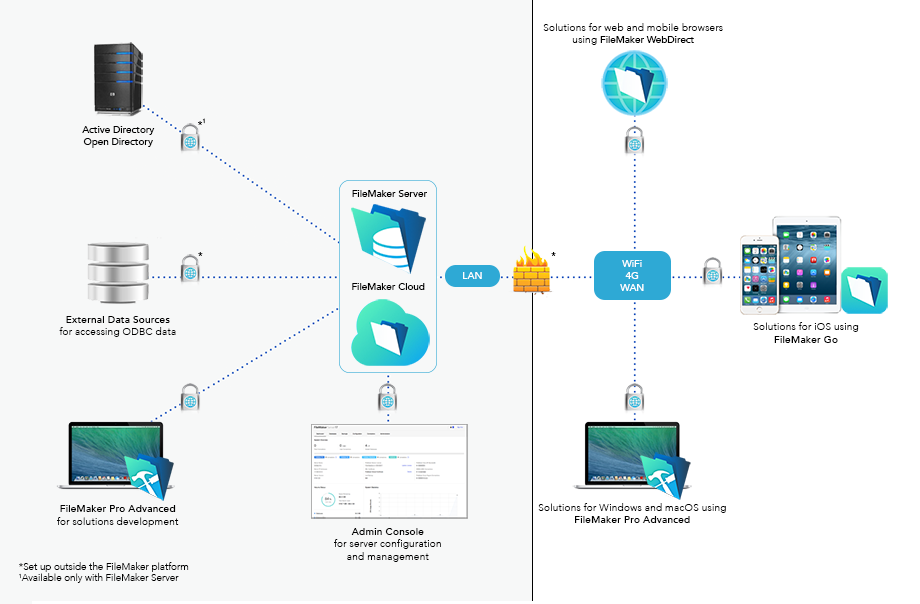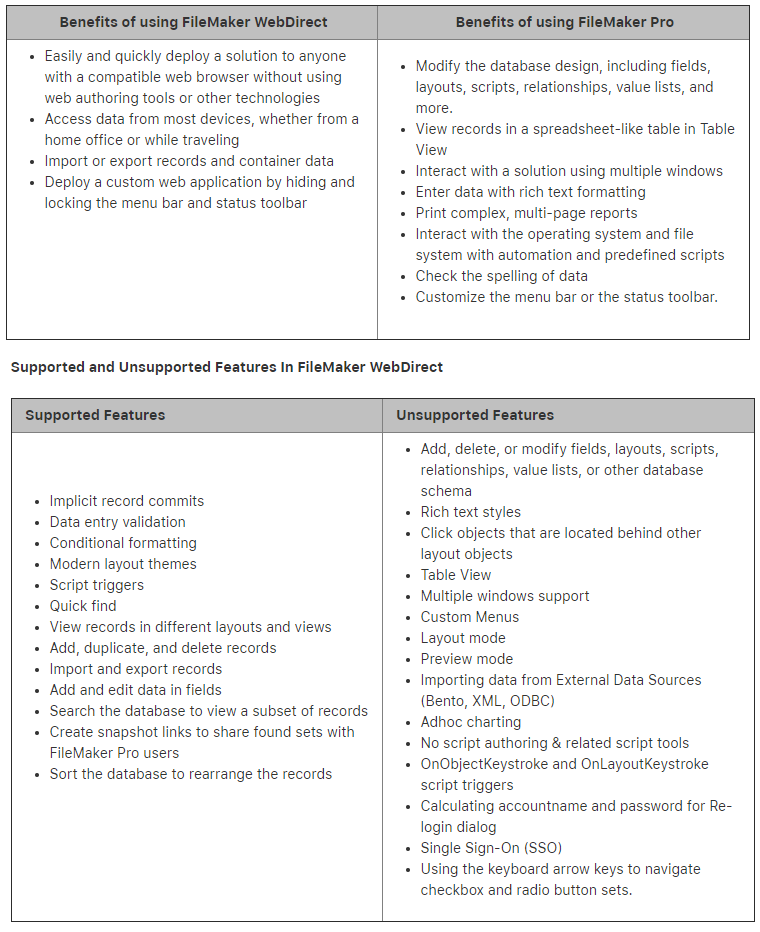- Get in touch: contact@filemakerconsulting.tech | +1343-777-8541 (Mon to Sat: 8am - 10pm EST)



FileMaker Pro is a cross-platform relational database application from Claris International. It integrates a database engine with a graphical user interface (GUI) and security features, allowing users to modify the database by dragging new elements into layouts, screens, or forms. Current versions are: FileMaker Pro Advanced 19, FileMaker Server 19, FileMaker Cloud 2.19.0, and FileMaker Go 19 for iPhone and iPad.
FileMaker Pro evolved from a DOS application, but was then developed primarily for the Apple Macintosh and released in April 1985. Since 1992, it has been available for Microsoft Windows and for the classic Mac OS and macOS, and can be used in a cross-platform environment. FileMaker server briefly ran on Linux, but Linux support was abandoned with FileMaker 7, thereafter only running on Windows or macOS servers. A client version was released for iOS devices in July 2010. It is available in desktop, server, iOS and web-delivery configurations. In 2016, FileMaker Cloud was introduced, including a Linux server (CentOS), which was offered exclusively through the Amazon Marketplace.
If any organization or business relies on spreadsheets, paper forms, or multiple applications to get the work done, they might consider using a FileMaker database solution instead. A FileMaker solution can bring disparate information together in one place and make it easy to add to, change, and query the data.
At its simplest, a FileMaker solution is made up of a database and a user interface. A database is a collection of information that is organized into files called tables. A user interface lets users view and interact with the information in the database.
FileMaker is a rapid application development (RAD) tool which doesn't require any compilation to host the solution. The developer can implement UI, scripting and database changes to a hosted solution without affecting the user's work. FileMaker solutions also allow for calculations, scripting, reporting, security, and integration with spreadsheets and other database systems.
Solutions can be big, up to 8 TB. Text fields can store up to 2 GB of text, and container fields can store up to 4 GB of binary data like images, audio, video, and PDF files.
An Excel spreadsheet is a kind of database called a flat-file database. It organizes its information into a single table. FileMaker uses relational databases. With a relational database, you store data in several tables and then define relationships between them.
For example, you could store donor information in one table and donation information in another. That way you would only have to enter a donor's information once, whereas in a spreadsheet you would have to enter it for each donation. A relational database prevents duplicate information and is less prone to error than a flat file.

Chart of table relationships as defined in a FileMaker solution
FileMaker Pro offers tools to simplify designing user interfaces. Often, it's as simple as dragging the fields you want to show onto a layout. You can create different layouts to show the same data in different ways. For example, you could browse donor records one at a time or view them all in one long list.
The software also contains dozens of built-in themes that use different colors, shapes, and typefaces. Some themes are designed for iOS devices and feature large, tap-friendly zones.

Same data, different themes
FileMaker Pro comes with 16 predefined solutions, called Starter Solutions. The data structures are all set up, and the layouts (components of the user interface) are all designed. These starter solutions acts as potential prototypes of the FileMaker Solution you might be looking to build.
This list of Starter Solutions might give you an idea of ways your organization could find FileMaker helpful. All these starter solutions can be easily extended to a custom solution.

FileMaker Starter Solutions
You can build a custom FileMaker solution from scratch to suit your particular needs. FileMaker Pro makes this fairly easy because you don't have to know SQL, the underlying programming language of most database systems. You still must know your way around data structures, though, and understand how to relate tables to one another. This is where we can help you in building your desired custom FileMaker Solution.
FileMaker Pro is a desktop application for designing and building custom solutions and using them once they are built. It runs on both Mac and Windows.
FileMaker Server hosts FileMaker solutions. It can also perform tasks like backing up automatically and logging statistics on usage and performance. You need the server if you have more than five people who will be connecting to a solution with FileMaker Pro or FileMaker Go.
FileMaker Pro Advanced adds features to FileMaker Pro, including tools for script debugging, customizing the product, and documenting a solution's internal structure.
FileMaker Go gives you access to FileMaker solutions on iOS devices. This capability is especially valuable for collecting data in the field, taking the place of clipboards and paper. You can also add photos, audio, video, and signatures. The connection can be made through Wi-Fi or a cellular connection, or the changes can be stored on the device and then synchronized later. FileMaker Go is a free app.
FileMaker WebDirect gives users access to FileMaker solutions in web browsers. FileMaker WebDirect is a feature of FileMaker Server, which must host the solution. The solution must be created in FileMaker Pro, but web users don't need to have it. See this comparison of what can and can't be done with WebDirect.
There are different benefits for using FileMaker Pro to access your solutions versus using FileMaker WebDirect. Although FileMaker WebDirect is very similar to FileMaker Pro, it does not have all the features of a FileMaker Pro network client. The following table provides some of the benefits of each:
